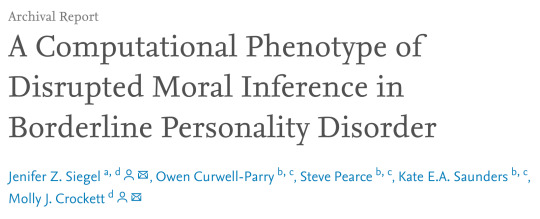#bayesian
Explore tagged Tumblr posts
Photo

Wake up early for workshop on Bayesian inference. Is this what they call "living the dream?"
79 notes
·
View notes
Photo

New Theory of How the Brain Generates Our Perceptions of the World
New research out of the University of Pennsylvania is filling in gaps between two prevailing theories about how the brain generates our perception of the world.
The research is in Nature Neuroscience. (full access paywall)
Research: “A Bayesian observer model constrained by efficient coding can explain 'anti-Bayesian' percepts” by Xue-Xin Wei and Alan A Stocker in Nature Neuroscience doi:10.1038/nn.4105
Image: A common misconception found across these studies was that dementia is a normal part of aging. Credit: The researchers/Research Square.
56 notes
·
View notes
Quote
Bayesians... they used to be viewed as the religious extremists of statistics, adhered to a set and rigid way of doing statistics. They couldn't calculate anything anyway so it didn't matter... Of course things have changed now.
STSCI 4030 (Applied Linear Statistical Models) discussion of Akaike vs. Bayesian info criterion for model selection
50 notes
·
View notes
Link
The radiolab story "It's Alive" made vivid the claim of Geoffrey West and Luis Bettencourt that a city's size determines how fast people walk in that city.
West & Bettencourt have written that people earn more in large cities, waste less, file more patents, and commit more crimes -- and that city size is the main determinant of all these things.
The charming Cosma Shalizi has recently published a 15-page paper that rebuts them. From the abstract:
Re-analysis of the gross economic production and personal income for cities in the United States, however, shows that the data cannot distinguish between power laws and other functional forms ... and that size predicts relatively little of the variation between cities.
The striking appearance of scaling in previous work is largely artifact of using extensive quantities (city-wide totals) rather than intensive ones (per-capita rates).
(Sorry if that's hard to read. Horizontal axis = log( city population ). Vertical axis = pedestrian speed in m/s, give or take a standard dev. Solid & dashed lines are two fits proposed by Bettencourt & West.
#Bayesian#news#nonparametric regression#power laws#scaling#statistics#long reads#math#maths#mathematics#science#heroes
31 notes
·
View notes
Text
I'm having a hard time mustering up sympathy for the type of people who died on one of the world's largest superyachts
30 notes
·
View notes
Text
Bayesian Decision Theory - AI2007 Lecture09 Bayesian Decision Theory.pdf by ntnu.edu.tw - pdf searches www.findp... http://ping.fm/uFyFL
23 notes
·
View notes
Link
There’s a Carnegie Mellon decision theory class that uses a logarithmic scoring rule for the midterm.
22 notes
·
View notes
Text





John Canton – Scientist of the Day
John Canton, a British mathematician and schoolmaster, was born July 31, 1718, in Stroud, Gloucestershire.
read more...
#John Canton#Thomas Bayes#Bayesian#probability#magnetism#histsci#histSTM#18th century#history of science#Ashworth#Scientist of the Day
18 notes
·
View notes
Text
This looks like a job for... Reversible-Jump Markov Chain Monte-Carlo!
(or: why I would make a really bad superhero)
17 notes
·
View notes
Link
This book is an absolute must-have if you do any type of geospatial analysis/modeling work. The author does an excellent job explaining complex theories and gives clear examples. Be sure to read the chapters on Bayesian methods and Fuzzy Logic...
16 notes
·
View notes
Photo

A computational phenotype of disrupted moral inference in borderline personality disorder (Siegel, Jenifer Z., et al.; Biological Psychiatry: Cognitive Neuroscience and Neuroimaging; 2020)
“Borderline personality disorder (BPD) is a serious mental disorder affecting up to 5.9% of the general population.
Marked disturbances in interpersonal relationships constitute one of the core symptom domains of BPD, including difficulties with trust and forgiveness often resulting in premature relationship termination. (…)
Several possible explanations have been proposed for why patients with BPD exhibit a poor ability to maintain interpersonal relationships.
For instance, building and maintaining successful social relationships depends on the ability to build accurate representations of others’ mental states (e.g., intentions, beliefs, desires);
however, research suggests that patients with BPD may be limited in their ability to accurately perceive social signals and model the intentions of others.
Notably, adaptive social functioning also depends on the ability to continuously update representations of others through social learning.
A growing body of theoretical and empirical work suggests that impaired social learning plays an important role in interpersonal disturbances in BPD, including difficulties trusting others.
Here, we consider an aspect of social learning that is especially relevant to forming and maintaining relationships: inferring others’ moral character; that is, whether they are helpful and trustworthy or harmful and untrustworthy. (…)
In optimal Bayesian inference, learning is intrinsically tied to prior expectations.
Observations that are consistent with prior expectations help reinforce them, while those that are inconsistent may be used to update expectations.
However, moral inference departs from Bayesian optimality in an important way:
healthy adults maintain more uncertain beliefs about the moral character of putatively bad agents even when observations are consistent with prior expectations.
We hypothesize that humans have evolved to rapidly discount prior expectations to adapt learning according to moral information.
This feature of healthy social cognition provides the flexibility to promptly update beliefs about bad agents when those beliefs turn out to be wrong, preserving social relationships in the wake of accidental harms.
One possibility is that BPD impacts cognitive processes important for the ability to adapt learning as a function of moral information.
In turn, patients may rely heavily on pessimistic prior expectations born from adversity and volatility in their social environment.
While the ability to rapidly discount externally generated prior expectations in moral inference may be advantageous in environments where social partners are consistently trustworthy, it can be costly when partners behave unpredictably.
By shutting down the gateway for learning when behavior misaligns with antisocial expectations, rigidity then provides a protective mechanism that prevents responding to unreliable social cues.
We found evidence consistent with the hypothesis that participants with untreated BPD may be especially reliant on pessimistic expectations in moral inference.”
13 notes
·
View notes
Text
Bayesian Learning - bay2.pdf by cs.cinvestav.mx - pdf searches www.findpdf.us http://ping.fm/nNtIL
20 notes
·
View notes
Text
Ignorance, Malice, Occam's Razor, and Bayesian Probability
You know that saying about how it's best to not attribute to malice what can be better explained by ignorance? That's an important thing. Came up in a discussion I had today, and I think it bears repeating for the world.
You see, ignorance and malice are two totally different things. (Note that 'ignorance', throughout this entire post, means accidental ignorance, not willful ignorance.) Therefore it's productive to give different responses.
Yes, when somebody offers up an idea that's counterproductive and kind of offensive, your first reaction is probably to fuck their shit up. This is pretty natural, really. But it only makes sense if they're suggesting this out of malice. But sit back and think for a moment.
The probability, assuming malicious intent, of them making the suggestion is probably pretty high. Let's say it's 90%. SoP(B|A)=.9. But that's not enough information to conclude the suggestion was made out of malice. Why?
Because in order to calculate the probability of malice, given the suggestion, we need to know both the probability of the suggestion overall, and the probability, prior to the suggestion, of malice. Let's assume for the moment that the suggestion is one that comes up occasionally. Let's pretend it's quite common in some places, but not here, and assign a 15% probability of the suggestion. Then, let's be a bit paranoid. Let's say there's a 30% prior on the malice. So we haveP(A)=.15andP(B)=.3.
Now we can do the math! Using Bayes' Theorem, we getP(A|B)=.45.
In other words, you're feeling pretty confident because it's basically the suggestion somebody who's out to get you would make, but 55%, the person making that suggestion isn't doing so because they're evil, it's because they don't know any better. And we should select the option which has the highest probability, which means it's time to set aside the explosives, and explain, very carefully, why it's a shit idea.
13 notes
·
View notes
Text
The cognitive burden of sending a single email
Sending emails is a Bayesian calculation, in which you attempt to predict a response to your message based on prior knowledge of the recipients, and a mental model of the message.
Whether you know it or not, you automatically create a mental model that takes into account various classifiers - topic, medium, time of day, length of communication, and a slew of other external factors.
You run your classifiers through your model, and predict each recipient's response.
Your predictions determine whether you can send the message, or whether you need to modify it.
You can change some of the classifiers such as message topic, content, recipients, length of communication, etc.
Then, you run your model again, or continuously, until you are satisfied with the predicted outcome.
If the computational burden is too high, or you don't have enough prior data to make a good prediction, or the intended result is unlikely, communication is discouraged.
The best communicators have a sophisticated mental model, and lots of prior learnings, to ensure that the predicted result matches their intentions.
What questions do you ask yourself, before you send an email?
12 notes
·
View notes
